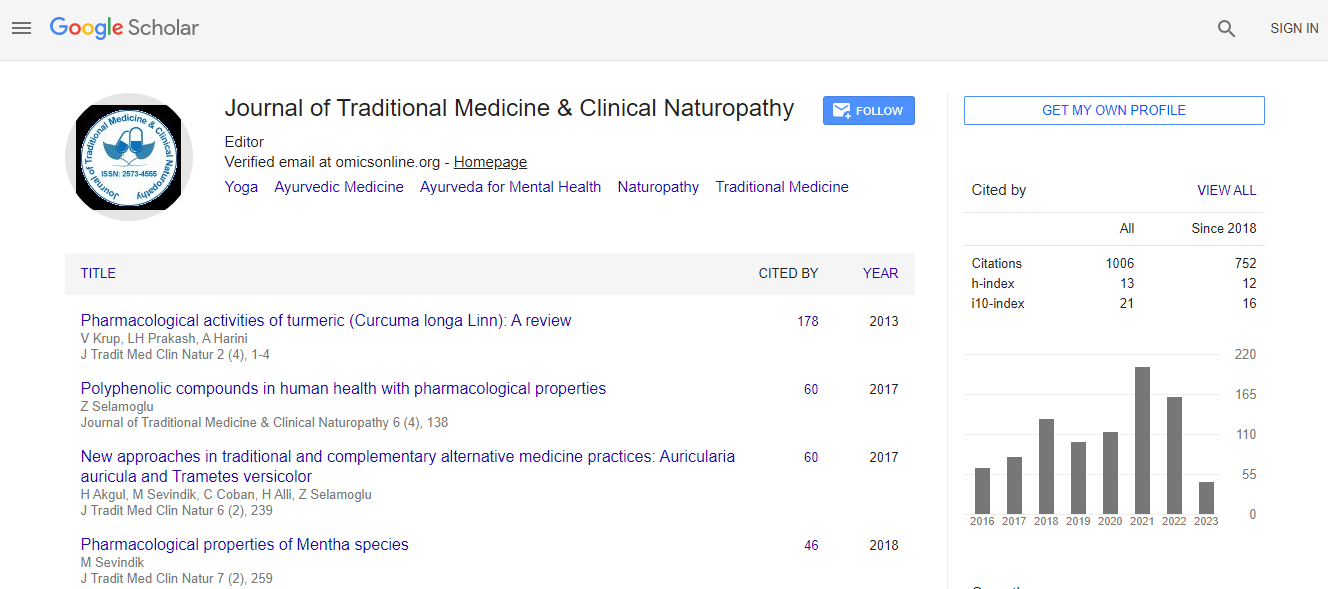Our Group organises 3000+ Global Conferenceseries Events every year across USA, Europe & Asia with support from 1000 more scientific Societies and Publishes 700+ Open Access Journals which contains over 50000 eminent personalities, reputed scientists as editorial board members.
Open Access Journals gaining more Readers and Citations
700 Journals and 15,000,000 Readers Each Journal is getting 25,000+ Readers
Google Scholar citation report
Citations : 1504
Journal of Traditional Medicine & Clinical Naturopathy peer review process verified at publons
Indexed In
- CAS Source Index (CASSI)
- Google Scholar
- Sherpa Romeo
- Open J Gate
- Genamics JournalSeek
- RefSeek
- Directory of Research Journal Indexing (DRJI)
- Hamdard University
- EBSCO A-Z
- Publons
- Geneva Foundation for Medical Education and Research
- Euro Pub
- ICMJE
Useful Links
Recommended Journals
Related Subjects
Share This Page
The power of nature captured for graceful skin
International Conference on Herbal & Traditional Medicine
Namrita Lall
University of Pretoria, South Africa
Keynote: J Tradit Med Clin Natur
Abstract
Cosmeceuticals are hybrids between drugs and cosmetic products and are able to enhance both health and beauty by external application which is very important for women specially. Everyone wants to look presentable else; it does affect one’s self esteem and confidence level. South Africa has tremendous plant diversity that is largely untapped in terms of its potential for medicinal and cosmeceutical purposes. With about 25 000 known species, this country is third only to Brazil and Indonesia as far as biodiversity is concerned. This constitutes about one tenth of all plant species in the world. Whether searching for ways to treat serious diseases like cancer and tuberculosis (TB), or formulating new acne creams and toothpastes that fight gum disease, one can be convinced that solutions can be found in South Africa’s indigenous plants. The vast traditional knowledge about SA’s plants is still untapped, and there is a huge amount of work needed to verify if and how traditional remedies and local plants actually work. The synergy of usage of plants traditionally coupled with all the rare plants found in this country prompted us to evaluate the potential of unexplored plants and develop products which can be applied topically. A number of plants have been proven to have effect for skin- problems for example melasma, spots, pigmentation, acne etc. and effective cosmeceutical-prototypes products have been prepared from those. Not all work; what are bring to the lab, on average only 2% reach a stage which are subjected to clinical studies. Due to the already existing products in the cosmetic market, one needs to check carefully how well the efficacy of newly invented SA indigenous plants; compares with the available ones. Secondly a few of the medicinal plants do not go further due to its sustainability (bark and roots of the plants may not be sustainability) and the toxicological profile of the samples. The key national benefit through these activities is the benefits that may be realised in bridging the gap between farmers, researchers and customers. By adding value to the local indigenous plants one can interest pharmaceutical companies to help in the development of novel cosmetic products. South Africa does not beneficiate enough local resources choosing rather to export. We can therefore not derive the value benefits third parties add to the resources in turning them into products. The result is that some of the local cosmetic companies import final products and we lose local beneficiation, local industry and jobs. We hope our project may lead to: Beneficiation of local endemic plant material; Infrastructure and upliftment in the community, help to create a local market for community farmers for raw materials; Import replacement; Job creation in local production; Future exports; Student training; and University technology transfer’.Biography
Lall has been placed in the Essential Science Indicators list of the top 1% of publication outputs (citations) in the discipline PHARMACOLOGY and TOXICOLOGY. Prof Lall has been recently appointed as an adjunct Professor at the School of Natural Resources University of Missouri, USA (Dept is 1 of the top 15 in the world) and as a Senior Research fellow at the Bio-Tech R&D Institute, Jamaica. She has international recognition for her research into the potential of medicinal plants for pharmaceutical and cosmeceutical purposes. One pharmaceutical product for skin-hyperpigmentation problem has been commercialised by international and national companies in European countries and in South Africa. Another twelve Pharmaceuticals prototypes have been licensed out to a pharmaceutical company. She has published 132 research articles, 15 patents, 24 book chapters and her H-index is 33 (researcher id:(http://www.researcherid.com/rid/A-26352012) and RG score is over 38 (Top 5%). A book on medicinal plants has recently been published by ELSEVIER. She has been awarded National Research Chair in Plant Health Products from IKS, by the NRF/DST in 2016. She obtained Biotech Fundi Lifetime Contribution Award by GDARD and Innovation hub (March 2017). In 2014, she received the Order of Mapungubwe - South Africa’s highest honour - from President Jacob Zuma, in recognition of her research.
E-mail: Namrita.lall@up.ac.za

 Spanish
Spanish  Chinese
Chinese  Russian
Russian  German
German  French
French  Japanese
Japanese  Portuguese
Portuguese  Hindi
Hindi 
